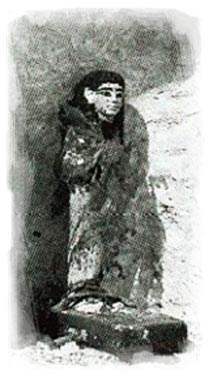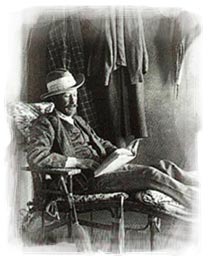|
The
Curse of the Mummies
 One
of the magic bricks found in King Tut's tomb. Four
of these magic bricks were found and each inscribed
with a portion of chapter 151 of the Book of the Dead.
One
of the magic bricks found in King Tut's tomb. Four
of these magic bricks were found and each inscribed
with a portion of chapter 151 of the Book of the Dead.
|
Legends
about the "Curse of the Pharaoh's" started around
the 7th Century when the Arabs arrived in Egypt. They
could not read the hieroglyphics so many things seemed mysterious
and strange to them. Also the remarkable preservation
of Mummies must have been a strange sight. Many stories were
told. They believed that if one entered a tomb and uttered
a magical formula, they would be able to materialize objects
made invisible by the ancient Egyptians. Also,
by magic, mummies could become alive again. They
also believed that the Egyptians would protect their tombs
by magical means (i.e. curses on anyone who entered).
THE
CURSE OF KING TUT
The
most famous story about a mummies curse occurred in 1923 when
King Tutankhaumum's tomb was discovered by Howard Carter.
Today everyone has heard of the young boy King Tut and his
treasures have toured the globe. Many books have been
published and many movies produced. Carter's patron
and sponsor of the excavation, Lord Carnarvon, had entered
the tomb with Carter. The tomb was virtually intact
and had never been broken into. They were the
first to enter since it was sealed in antiquity. What
happened several weeks afterwards was the following.
Lord Carnarvon got a mosquito bite that became infected and
this led to pneumonia which he died from. At the time
of his death there was a complete black-out in Cairo and Carnavon's
dog in far-off England started howling at that instant.
This story was spread all over the world and the interest
in the "Curse of the Pharaohs" was rekindled.
Today, many people probably think there was a curse on the
tomb of King Tutankhaumum and that most of the people who
entered the tomb died strange deaths. This is actually
not true. What are the facts?
Lord
Carnavon was in poor health for many years before he arrived
in Egypt and entered the tomb. A mosquito bite that
he received had become infected and because of his ill health
led to pneumonia and he died from this. The occurrence
of the lights going out in Cairo was also reported but this
was a common occurrence, even today, in Cairo. The
newspapers published the text of the alleged curse: "Death
shall come on swift wings to him that toucheth the tomb of
a pharaoh". Actually, Tutankhamum's curse was a
mistranslation of a protective spell inscribed on a magic
brick from the tomb (see photo above). Four magic bricks were
found in the tomb in niches at the cardinal directions to
form a defensive perimeter and support. There was never
a curse that was found written in the tomb of Tutankhaumum.
The curse story was spread by uninformed news reporters and
others who wanted to make a sensational story regarding Carnavon's
death.
What
about the others that entered the tomb? What happened
to them if there was a curse?
At
the opening of the tomb, 26 people were present. Only
6 died within 10 years. At the opening of the
sarcophagus, there were 22 people present. Only 2 died
within 10 years. At the unwrapping of the mummy, 10
people were present. None died within 10 years.
In fact the Doctor who performed the autopsy on King Tut's
mummy lived for another 20 years. What about Howard
Carter who was the first to enter the tomb in 1923.
He died 16 years later in 1939.
BUT
it should be noted that genuine curses have been found in
other tombs.
 Lord Carnarvon (George Herbert,
Earl of Carnarvon
Lord Carnarvon (George Herbert,
Earl of Carnarvon |
|

|
THE MUMMY ON THE TITANIC
There
is an interesting story regarding the prestigious British
Museum. They had been reputed to own a mummy which had
a curse on it. They decided to get rid of it so they
arranged to sell it to an American Institution. They
arranged for it to be shipped to America on the Titanic.
We know what happened and today many people think the Titanic
sank because of the presence of the mummy on board.
Actually,
this story was completely made up and the only truth in it
is that the alleged mummy is actually a coffin lid, which
is still present to this day in the British Museum.
THE
FLIGHT OF THE BRITANNIA
In
1972 in commemoration of the 50th anniversary of the discovery
of King Tut's tomb, some of the treasures from the tomb
we sent to select museums in other countries for display.
Some of the treasures were sent to England in crates aboard
a Royal Air Force Britannia aircraft. A technical officer
thought it would be funny to kick the crate which contained
King Tut's Royal Mask. Two years latter, he broke that
same leg. Another crew member got a divorce some time
afterwards and blamed the curse. Two other members
had heart attacks and they believed it was caused by the curse.
This story was reported in September, 1978 in the "News
of the World" newspaper.
CURSES
FROM PRIVATE TOMBS
As
mentioned above, there were no curses found in the tomb of
Tutankhaumum, but genuine curses have been found in other
tombs. Most royal tombs did not have curses but curses
have been found at private tombs. They usually appear
in tombs of the Old Kingdom. They basically consist
of the owner of the tomb invoking judgment in the underworld
on any tomb violators. Here are some examples of tomb
curses found on private tombs in the Old Kingdom period.
"As
for any man who will make a disturbance, I shall be judged
with him"
"A
crocodile be against him in the water; a snake be against
him on land, he who would do anything against this tomb.
Never did I do a thing against him. It is the
god who will judge."
Here
is an interesting curse from the tomb of Ankhmahor from Saqqara
(Old Kingdom period).
"As
for anything that you might do against this tomb of mine of
the West, the like shall be done against your property.
I am an excellent lector priest, exceeding knowledgeable in
secret spells and all magic. As for any person who will
enter into this tomb of mine in their impurity, having eaten
the abominations that excellent akh-spirits abominate, or
who do not purify themselves as they should purify themselves
for an excellent akh who does what his lord praises, I shall
seize him like a goose (wring his neck), placing fear in him
at seeing ghosts upon earth, that they might be fearful of
an excellent akh... But as for anyone who will enter into
this tomb of mine being pure and peaceful regarding it, I
shall be his protective backer in the West in the court of
the great god."
Some
more unusual curses are the "Donkey Curse" which
threaten the violator of the tomb with rape by a donkey, the
animal of Seth.
A
most complete curse comes from the administrator of the 18th
dynasty, Amenhotep, son of Hapu. He threatens
anyone who would damage his tomb with a lengthy list of punishments.
They would "lose their earthly positions and honors,
be incinerated in a furnace in execration rites, capsize and
drown at sea, have no successors, receive no tomb or funerary
offerings of their own, and their bodies would decay because
they will stave without sustenance and their bones will perish".
This curse does not leave much out.
CONCLUDING
OBSERVATIONS
There
are cases that at the opening of a sealed tomb, some people
have been affected by illness and infection. This may
be the result of poisonous moulds and bacteria in the tomb.
Poisonous gases have also been known to cause illness to archeologists.
In
the 1940's, when an archeologist, Sami Gabra, was working
in tombs in the ibis-necropolis of Tuna el-Gebel, both he
and his workers were seized by violent headaches and shortness
of breath. The workers thought it was a curse of the
ibis-headed god, Thoth. In reality, it was discovered
that the cause was noxious gas, and after it was removed,
they returned to work.
An
Interesting Note: The curses were directed at tomb robbers
and those who sought to despoil the tomb. It may be
that since Egyptologists make the name of the dead live by
their discoveries and publications, (and therefore the soul),
they would not be punished but actually be blessed by the
ancients.
REFERENCES:
Ancient
Egypt, David Silverman, 1997
The Encyclopedia of Mummies, Bob Brier, 1998
Mummies, Myth and Magic, Christine El Mahdy, 1989
The Mummy in Ancient Egypt, Salima Ikram, 1998
|
|